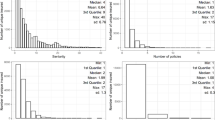Abstract
A “fleet” insurance policy covers a number of motor vehicles, usually five or more, owned by a business firm. The issue addressed in this paper is whether the design of such policies should differ from that of single-vehicle insurance plans. Specifically, I inquire whether the size of a fleet matters for the loss reimbursement schedules. The intuition is that, even over a single contract period (say a year), the loss experience for a large fleet may be expected to provide relatively precise information with respect to a firm’s risk class or risk management policies. Presumably, this should make it possible to provide better insurance coverage, while maintaining the screening of bad risks and the incentives to reduce accident frequencies.
I wish to thank two anonymous referees for helpful comments and suggestions. The financial support of the Québec FCAR is gratefully acknowledged.
Access this chapter
Tax calculation will be finalised at checkout
Purchases are for personal use only
Preview
Unable to display preview. Download preview PDF.
Similar content being viewed by others
References
Chiappori, P.A., Macho, I., Rey, P., and B. SALANIé (1994), “Repeated Moral Hazard: The Role of Memory, Commitment, and the Access to Credit Markets”, European Economic Review, 38: 1527–1553.
Dionne, G., and P. Lasserre (1985), “Adverse Selection, Repeated Insurance Contracts and Announcement Strategy”, Review of Economic Studies, 52: 719–723.
Dionne, G., and C. Vanasse (1992), “Automobile Insurance Ratemaking in the Presence of Asymmetrical Information”, Journal of Applied Econometrics, 7: 149–165.
Eeckhoudt, L., Bauwens, L., Briys, E., and P. Scarmure (1991), “The Law of Large (Small?) Numbers and the Demand for Insurance”, Journal of Risk and Insurance, 58: 438–451.
Henriet, D., and J. C. Rochet (1986), “La logique des systèmes bonus-malus en assurance automobile: une approche théorique”, Annales d’économie et de Statistiques, 1: 133–152.
Holmström, B. (1979), “Moral Hazard and Observability”, Bell Journal of Economics, 10:74–91.
Kim, S.K. (1995), “Efficiency of an Information System in an Agency Problem”, Econometrica, 63: 89–102.
Lambert, R. (1983), “Long-Term Contracting and Moral Hazard”, Bell Journal of Economics, 14: 441–452.
Landsberger, M., and I. Meilijson (1996), “Extraction of Surplus under Adverse Selection: The Case of Insurance Markets”, Journal of Economic Theory, 69(1): 234–239.
Lemaire, J. (1996), Automobile Insurance, Kluwer Academic Publishers, Boston.
Mirrlees, J. (1974), “Notes on Welfare Economics, Information and Uncertainty”, in M. Balch, D. Mcfadden, and S. Wu (eds.), Essays in Economic Behavior Under Uncertainty, North-Holland, Amsterdam: 243–258.
Rogerson, W. (1985), “Repeated Moral Hazard”, Econometrica, 53: 69–76.
Rothschild, M., and J. Stiglitz (1976), “Equilibrium in Competitive Insurance Markets: An Essay on the Economics of Imperfect Information”, Quarterly Journal of Economics, 90: 629–650.
Rubinstein, A., and M. Yaari (1983), “Repeated Insurance Contract and Moral Hazard”, Journal of Economic Theory, 30: 74–97.
Samuelson, P. A. (1963), “Risk and Uncertainty: A Fallacy of Large Numbers”, Scientia, 6th Series, 57: 1–6.
Editor information
Editors and Affiliations
Rights and permissions
Copyright information
© 1999 Springer Science+Business Media New York
About this chapter
Cite this chapter
Fluet, C. (1999). Commercial Automobile Insurance: Should Fleet Policies Differ from Single Vehicle Plans?. In: Dionne, G., Laberge-Nadeau, C. (eds) Automobile Insurance: Road Safety, New Drivers, Risks, Insurance Fraud and Regulation. Huebner International Series on Risk, Insurance, and Economic Security, vol 20. Springer, Boston, MA. https://doi.org/10.1007/978-1-4615-4058-8_5
Download citation
DOI: https://doi.org/10.1007/978-1-4615-4058-8_5
Publisher Name: Springer, Boston, MA
Print ISBN: 978-1-4613-6817-5
Online ISBN: 978-1-4615-4058-8
eBook Packages: Springer Book Archive




